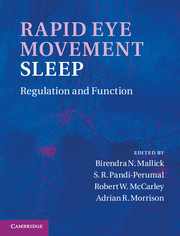Book contents
- Frontmatter
- Contents
- Contributors
- Preface
- Acknowledgments
- Organization
- Section I Historical context
- Section II General biology
- Section III Neuronal regulation
- 10 Understanding REM sleep: clues from brain lesion studies
- 11 Preoptic and basal forebrain modulation of REM sleep
- 12 Amygdalar regulation of REM sleep
- 13 Pontomedullary mediated REM-sleep atonia
- 14 Phenomenology and function of myoclonic twitching in developing rats
- 15 Pontine-wave generator: a key player in REM sleep-dependent memory consolidation
- 16 Hippocampal theta rhythm of REM sleep
- 17 Respiration during REM sleep and its regulation
- 18 Modulation of REM sleep by non-REM sleep and waking areas in the brain
- Section IV Neuroanatomy and neurochemistry
- Section V Functional significance
- Section VI Disturbance in the REM sleep-generating mechanism
- Index
- Plate section
- References
10 - Understanding REM sleep: clues from brain lesion studies
from Section III - Neuronal regulation
Published online by Cambridge University Press: 07 September 2011
- Frontmatter
- Contents
- Contributors
- Preface
- Acknowledgments
- Organization
- Section I Historical context
- Section II General biology
- Section III Neuronal regulation
- 10 Understanding REM sleep: clues from brain lesion studies
- 11 Preoptic and basal forebrain modulation of REM sleep
- 12 Amygdalar regulation of REM sleep
- 13 Pontomedullary mediated REM-sleep atonia
- 14 Phenomenology and function of myoclonic twitching in developing rats
- 15 Pontine-wave generator: a key player in REM sleep-dependent memory consolidation
- 16 Hippocampal theta rhythm of REM sleep
- 17 Respiration during REM sleep and its regulation
- 18 Modulation of REM sleep by non-REM sleep and waking areas in the brain
- Section IV Neuroanatomy and neurochemistry
- Section V Functional significance
- Section VI Disturbance in the REM sleep-generating mechanism
- Index
- Plate section
- References
Summary
Summary
We have used the brain lesion method and chronically maintained cats to elucidate the contribution of key encephalic structures to the control of REM sleep. The results indicate that the physiological processes that participate in REM sleep generation and maintenance are all located in the pons, with the exception of those involved in REM sleep homeostasis. As we have shown, after a mesencephalic transection, REM sleep-deprived cats show a strong REM sleep pressure, but rebound does not occur. This finding indicates that the pontine mechanisms are modulated by a complex forebrain system, which, as we have shown, originates in the neocortex and has a powerful diencephalic stage. Part of this descending influence is a permissive mechanism for REM sleep rebound, which probably originates in the hypothalamus. Therefore the ultimate control of REM sleep rebound originates in the forebrain. This makes sense because it allows for a needed tight coupling with NREM sleep, which, as is well known, is also controlled by the forebrain. We have demonstrated that the electrocortical desynchronization induced by REM sleep is stronger that the one seen during waking (W), and this allows for REM sleep to accomplish what, we believe, is perhaps an REM sleep main function, i.e., to maintain the continuity of true sleep (S) given the limited duration of NREM sleep periods (by co-opting W at the end of NREM sleep periods).
- Type
- Chapter
- Information
- Rapid Eye Movement SleepRegulation and Function, pp. 89 - 98Publisher: Cambridge University PressPrint publication year: 2011

